Balbharti Maharashtra State Board 12th Biology Important Questions Chapter 6 Plant Water Relation Important Questions and Answers.
Maharashtra State Board 12th Biology Important Questions Chapter 6 Plant Water Relation
Multiple Choice Questions
Question 1.
What is the reason behind various properties of water?
(a) Physical state
(b) Hydrogen bonding
(c) Colour
(d) Fluidity
Answer:
(b) Hydrogen bonding
Question 2.
Which special type of tissue is present in epiphytic roots?
(a) Velamen
(b) Lenticel
(c) Aerenchyma
(d) Haustoria
Answer:
(a) Velamen
![]()
Question 3.
In which zone of root we come across root hairs?
(a) meristematic region
(b) zone of elongation
(c) zone of absorption
(d) maturation zone
Answer:
(c) zone of absorption
Question 4.
In double layered cell wall of root hair, outer layer is of ……………..
(a) cellulose
(b) pectin
(c) cutin
(d) suberin
Answer:
(b) pectin
Question 5.
What is rhizosphere?
(a) Root ball formed by growth of roots
(b) Covering of root tip
(c) Microenvironment around root
(d) region of root hairs
Answer:
(c) Microenvironment around root
Question 6.
A root hair is derived from …………….. cell.
(a) epidermal
(b) cortical
(c) endodermal
(d) pericycle
Answer:
(a) epiderinal
Question 7.
When we keep raisins in water they swell up, due to ……………..
(a) exosmosis
(b) plasmolysis
(c) imbibition
(d) diffusion
Answer:
(c) imbibition
Question 8.
This phenomenon is associated with exchange of gases ……………..
(a) osmosis
(b) diffusion
(c) imbibition
(d) plasmolysis
Answer:
(b) diffusion
Question 9.
What is correct expression for diffusion pressure deficit (D.PD.)?
(a) D.PD. = O.R – S.E
(b) D.PD. = T.E – O.E
(c) D.PD. = W.E – T.R
(d) D.PD. = O.R – T.R
Answer:
(d) D.PD. = O.P – T.P
Question 10.
What is true for a turgid cell?
(a) T.R is zero
(b) T.R = S.R
(c) D.P.D. is zero
(d) W.R = S.R
Answer:
(c) D.P.D. is zero
Question 11.
The particles which easily diffuse through cell membrane are ……………..
(a) lipid soluble
(b) water soluble
(c) hydrophilic
(d) lipophobic
Answer:
(a) lipid soluble
Question 12.
Which proteins help in facilitated diffusion process?
(a) cutin
(b) mucin
(c) aquaporins
(d) lipoproteins
Answer:
(c) aquaporins
Question 13.
D.PD. is now known as ……………..
(a) water potential
(b) solute potential
(c) pressure potential
(d) osmotic potential
Answer:
(a) water potential
Question 14.
Water always flows from ……………..
(a) more negative water potential to less negative water potential
(b) high water potential area to low water potential area
(c) low water potential area to high water potential area
(d) negative water potential area to area of zero water potential
Answer:
(b) high water potential area to low water potential area
Question 15.
Plasmolysed cell becoming turgid is process of ……………..
(a) replasmolysis
(b) incipient plasmolysis
(c) deplasmolysis
(d) exosmosis
Answer:
(c) deplasmolysis
Question 16.
In a fully turgid cell ……………..
(a) T.P = O.P
(b) T.P = S.P
(c) O.P = S.P
(d) T.RP = 0 (zero)
Answer:
(a) T.P = O.P
Question 17.
Casparian strip of endodermis has material ……………..
(a) pectin
(b) suberin
(c) cutin
(d) porin
Answer:
(b) suberin
Question 18.
Water from pericycle is forced into xylem due to ……………..
(a) aquaporin
(b) plasmodesmata
(c) root pressure
(d) ion-channels
Answer:
(c) root pressure
Question 19.
Water absorbed from root hair when passes through intercellular spaces and cell wall it is …………….. pathway.
(a) apoplast
(b) symplast
(c) transmembrane
(d) plasmodesmata
Answer:
(a) apoplast
Question 20.
In root system, secondary roots arise from ……………..
(a) cortical cells
(b) endodermis
(c) pericycle
(d) passage cell
Answer:
(c) pericycle
Question 21.
Active absorption of water occurs during ……………..
(a) early morning
(b) daytime
(c) bright sunlight
(d) night time
Answer:
(d) night-time
Question 22.
The value of root pressure is usually about ……………..
(a) +1 to +12 bars
(b) -1 to +1 bars
(c) +1 to +2 bars
(d) +1 to +21 bars
Answer:
(c) +1 to +2 bars
Question 23.
The ascent of sap in plants takes place through ……………..
(a) xylem
(b) phloem
(c) parenchyma
(d) endodermis
Answer:
(a) xylem
![]()
Question 24.
From the following, which water will show greatest water potential (ψ)
(a) pure water
(b) salt water
(c) sugar water
(d) salt + sugar + water
Answer:
(a) pure water
Question 25.
Due to entry of water in a cell, the pressure potential ……………..
(a) increases
(b) decreases
(c) remains unaffected
(d) becomes zero
Answer:
(a) increases
Question 26.
Which mineral element is not remobilized in plants?
(a) P
(b) K
(c) S
(d) Ca
Answer:
(d) Ca
Question 27.
Phloem sap analysis is done using isotope ……………..
(a) 16O
(b) 14C
(c) 15N
(d) 35S
Answer:
(b) 14C
Question 28.
In plants, food is mainly translocated in form of ……………..
(a) starch
(b) glucose
(c) sucrose
(d) amino acids
Answer:
(c) sucrose
Question 29.
Transport of food through phloem is ……………..
(a) unidirectional
(b) bidirectional
(c) three dimensional
(d) absent
Answer:
(b) bidirectional
Question 30.
Guttation occurs through ……………..
(a) stomata
(b) lenticels
(c) hydathodes
(d) velamen
Answer:
(c) hydathodes
Question 31.
Amount of cuticular transpiration is about ……………..
(a) 0.1-1%
(b) 8 – 10%
(c) 90 – 93%
(d) 2 – 8%
Answer:
(b) 8 – 10%
Question 32.
Epistomatic leaf shows ……………..
(a) stomata on upper side
(b) stomata on lower side
(c) stomata on both surfaces
(d) absence of stomata
Answer:
(a) stomata on upper side
Question 33.
Dumbbell shaped guard cells are found in ……………..
(a) most dicots
(b) grasses
(c) gymnosperms
(d) desert plants
Answer:
(b) grasses
Question 34.
Stomatal transpiration occurs during night time in ……………..
(a) most dicots
(b) grasses
(c) gymnosperms
(d) desert plants
Answer:
(d) desert plants
Question 35.
Reservoir of K+ ions is ……………..
(a) guard cells
(b) epidermal cells
(c) subsidiary cells
(d) mesophyll
Answer:
(c) subsidiary cells
Question 36.
Guard cells are surrounded by ……………..
(a) epidermal hairs
(b) mesophyll cells
(c) accessory cells
(d) lenticels
Answer:
(c) accessory cells
Question 37.
When guard cells close stomata at night which acid prevents uptake of K+ and C– ions?
(a) Abscissic acid
(b) Pyruvic acid
(c) Malic acid
(d) Acetic acid
Answer:
(a) Abscissic acid
Question 38.
Which type of injury is noticed in plants if there is excessive transpiration?
(a) Burning
(b) Chlorosis
(c) Necrosis
(d) Wilting
Answer:
(d) Wilting
Question 39.
Maximum transpiration occurs through ……………..
(a) cuticle
(b) lenticels
(c) stomata
(d) bark
Answer:
(c) stomata
Question 40.
What will be the condition of guard cells during night-time?
(a) Show increased turgor pressure
(b) Become flaccid
(c) Increase uptake of K+ and Cl– ions
(d) Starch converted to sugar
Answer:
(b) Become flaccid
Question 41.
Cell A has water potential – 10 bars and cell B has – 5 bars, the movement of water will occur from ……………..
(a) A to B
(b) B to A
(c) No movement
(d) Either A to B or B to A
Answer:
(b) B to A
Question 42.
What is the correct symbol and unit of water potential?
(a) ψ and ha
(b) ω and ha
(c) ω and Pa
(d) ψ and Pa
Answer:
(d) ψ and Pa
Question 43.
When root system absorbs water, which is the first physical process concerned with this activity?
(a) Osmosis
(b) Imbibition
(c) Facilitated diffusion
(d) Diffusion
Answer:
(b) Imbibition
Match the columns
Question 1.
| Column A (Scientist) | Column B (Theory) |
| (1) Munch | (a) Proton transport theory |
| (2) Bohem | (b) Pressure flow theory |
| (3) J. Pristley | (c) Capillary theory |
| (4) Levitt | (d) Root Pressure theory |
Answer:
| Column A (Scientist) | Column B (Theory) |
| (1) Munch | (b) Pressure flow theory |
| (2) Bohem | (c) Capillary theory |
| (3) J. Pristley | (d) Root Pressure theory |
| (4) Levitt | (a) Proton transport theory |
Question 2.
| Column A (Scientist) | Column B (Theory) |
| (1) Dixon and Joly | (a) Starch-sugar inter conversion |
| (2) Steward | (b) Osmotic absorption theory |
| (3) Atkins and Pristley | (c) Non-osmotic absorption theory |
| (4) Kramer and Thimann | (d) Cohesion tension theory |
Answer:
| Column A (Scientist) | Column B (Theory) |
| (1) Dixon and Joly | (d) Cohesion tension theory |
| (2) Steward | (a) Starch-sugar inter conversion |
| (3) Atkins and Pristley | (b) Osmotic absorption theory |
| (4) Kramer and Thimann | (c) Non-osmotic absorption theory |
Question 3.
| Column A | Column B (New Terminology) |
| (1) D.P.D. | (a) Osmotic potential |
| (2) O.E | (b) Pressure potential |
| (3) T.P | (c) Water potential |
Answer:
| Column A | Column B (New Terminology) |
| (1) D.P.D. | (c) Water potential |
| (2) O.E | (a) Osmotic potential |
| (3) T.P | (b) Pressure potential |
Classify the following to form Column B as per the category given in Column A
Question 1.
B, Co, Mn, P, N, S
| Column A | Column B |
| Macro elements | ——–, ———-, ——– |
| Micro elements | ——–, ———-, ——– |
Answer:
| Column A | Column B |
| Macro elements | P, N, S |
| Micro elements | B, Co, Mn |
![]()
Question 2.
Capillary water, Combined water, Hygroscopic water, Gravitational water.
| Column A | Column B |
| (1) Water adsorbed on soil particles | ————— |
| (2) Water penetrated deep in soil | ————– |
| (3) Water present as hydrated oxides | ————- |
| (4) Water present between soil particles | ————- |
Answer:
| Column A | Column B |
| (1) Water adsorbed on soil particles | Hygroscopic water |
| (2) Water penetrated deep in soil | Gravitational water |
| (3) Water present as hydrated oxides | Combined water |
| (4) Water present between soil particles | Capillary water |
Very short answer question
Question 1.
Why water acts as a thermal buffer?
Answer:
The water has high specific heat, high heat of vaporization and high heat of fusion hence it acts as a thermal buffer.
Question 2.
Why water can easily rise in capillaries?
Answer:
Water has high surface tension and high adhesive and cohesive force hence it can easily rise in capillaries.
Question 3.
Enlist the kind of water available in soil environment.
Answer:
Soil environment has gravitational water, hygroscopic water, combined water and capillary water.
Question 4.
Mention examples of imbibition process.
Answer:
Soaking of seeds, swelling up of raisins, kneading of flour and warping of wooden doors in rainy season.
Question 5.
What is the mechanism of imbibition?
Answer:
When imbibition takes place water molecules (imbibate) get tightly adsorbed on imbibant without formation of solution.
Question 6.
Why water enters plant cell by process of diffusion?
Answer:
Water present around cell wall has more diffusion pressure than inner cell sap hence water moves in the cell through freely permeable cell wall by diffusion.
Question 7.
What is isotonic condition in osmotic system?
Answer:
A condition where concentration of solution has neither gain nor loss of water in an osmotic system is isotonic.
Question 8.
What is effect on protoplasm when cell is plasmolysed ?
Answer:
When cell is plasmolysed, protoplast of cell shrinks and recedes from the cell wall thus gap is observed between cell wall and protoplast.
Question 9.
What is apoplast pathway?
Answer:
When water absorbed by root hair passes across the roots through cell wall and intercellular spaces of root cortex it is called apoplast pathway.
Question 10.
Which experiment is a proof for existence of root pressure?
Answer:
When a stem of potted plant is cut above the soil, xylem sap is seen oozing through cut end, that proves presence of root pressure.
Question 11.
Which analysis indicates that minerals are absorbed by plants?
Answer:
Analysis of plant ash contents is indication of absorbed minerals.
Question 12.
Which ions are readily remobilized in plants?
Answer:
Ions of phosphorus, sulphur and nitrogen are remobilized from older plants, parts (leaves) to younger parts.
Question 13.
What is radial and tangential translocation?
Answer:
When lateral translocation of food occurs in root or stem, transport from phloem to pith is radial translocation while that from phloem to cortex is tangential translocation.
Question 14.
What is loading of vein?
Answer:
In turgid cell, due to increased turgor pressure of photosynthetic cell, sugar is forced into the sieve tube of the vein, which is known as loading of vein.
Question 15.
What is unloading of vein?
Answer:
At the sink end, turgor pressure is lowered and hence turgor pressure gradient is developed from sieve-tube which translocates food passively along concentration gradient, this is vein unloading.
Question 16.
What is peculiarity of wall of guard cells?
Answer:
The inner wall of guard cell that faces opening is thick and inelastic while its outer wall or lateral wall is thin and elastic.
Question 17.
Give reaction of starch-sugar interconversion theory.
Answer:

Question 18.
How do land plants absorb water and mineral salts from the soil?
Answer:
Land plants absorb water and mineral salts from soil with the help of their roots.
Question 19.
In which form the water is lost from leaves to the atmosphere?
Answer:
The water is lost in the form of vapour from leaves to the atmosphere.
Question 20.
How does plants lift the water from soil up to canopy without any pump?
Answer:
Plants have vascular tissue system of xylem, mainly through vessels and tracheids. Water is conducted upwards due to pull created in this continuous channel of water.
Question 21.
What is a peculiarity of epiphytic plants like orchids?
Answer:
The epiphytic plants like orchids have epiphytic roots with special water vapour absorbing layer of velamen tissue that absorbs water vapour from air.
![]()
Question 22.
What are root hairs?
Answer:
Root hairs are the extensions of epiblema or epidermal cells in the region of absorption.
Question 23.
Why do the wooden doors become very hard to close and open in rainy season?
Answer:
During rainy season wooden doors swell up due to imbibition of water. The humidity or moisture content of air increases and wood which is hydrophilic takes up this moisture.
Question 24
How does the water come out through the surface of porous earthen pot?
Answer:
Earthen pot has tiny pores through which water diffuses out. Due to evaporation of this water from surface water kept inside becomes cool.
Question 25.
Describe external structure of root hair.
Answer:
A root hair is a cytoplasmic extension of epiblema cell which is colourless, unbranched, ephemeral, very delicate tubular structure of about 1 to 10 mm long.
Question 26.
What is gravitational water?
Answer:
Water present in the soil that percolates deep inside due to gravitational force is called gravitational water.
Question 27.
How can we describe osmotic movement of water related to energy?
Answer:
The osmotic movement of water is on the basis of free energy which is used to do work.
Question 28.
Which process is responsible for transport of minerals and to make them available to cells?
Answer:
The minerals absorbed by roots are transported upwards through sap and from veins by process of diffusion cells uptake them.
Question 29.
Give examples of vertical translocation of food in downward direction and upward direction.
Answer:
Food is translocated in downward direction from leaves (source) to root, while during germination of seed, bulbil, corm it is in upward direction.
Question 30.
What is translocation of food?
Answer:
The transport of food from one part of plant to the other part, i.e. source to sink is called translocation of food.
Question 31.
Which plant tissues are involved in transport of water, minerals and food?
Answer:
A complex plant tissue xylem, mainly with its tracheids and vessels is involved in transport of water and minerals while complex tissue phloem with sieve tubes and companion cells is involved in transport of food.
Question 32.
Which is a direct pathway of transport available in plants through root system?
Answer:
Secondary roots that originate from pericycle that is outer layer of vascular cylinder, bypass endodermis with Casparian strip allow direct apoplast pathway to enter xylem and phloem.
Question 33.
For which type of plants root pressure theory of ascent of sap is applicable?
Answer:
Root pressure theory is applicable to plants having height up to 10 to 20 metres.
Question 34.
What is hydrogen bond?
Answer:
Hydrogen bond results from the attractive force between a hydrogen atom covalently bonded to a very electronegative atom like O or N.
Question 35.
When you burn an incense stick in one corner of room, its fragrance spreads all over the room in a short time. How does it happen?
Answer:
The process of diffusion is responsible for spreading the fragrance of an incense stick in one corner of room.
Give definitions of the following
Question 1.
Facilitated diffusion
Answer:
The passive absorption of solutes when mediated by a carrier is called facilitated diffusion.
Question 2.
Osmotic pressure / Osmotic potential
Answer:
The pressure exerted due to osmosis is osmotic pressure now termed as osmotic potential.
Question 3.
Deplasmolysis
Answer:
When plasmolysed cell is placed in hypotonic solution, endo-osmosis occurs making cell turgid again then this is called deplasmolysis.
Question 4.
Translocation of food
Answer:
The movement of food from one part of plant to the other part is called translocation of food.
Name the following
Question 1.
Condition of cell wall and cell membrane : based on permeability.
Answer:
Cell wall freely permeable and Cell membrane semipermeable.
Question 2.
Weak solution having low osmotic concentration.
Answer:
Hypotonic
Question 3.
Strong solution having high osmotic concentration.
Answer:
Hypertonic
Question 4.
A suberised layer on endodermis.
Answer:
Casparian strip
Question 5.
One example of each epistomatic, hypostomatic and amphistomatic leaf.
Answer:
- Epistomatic leaf – Lotus
- Hypostomatic – Nerium.
- Amphistomatic – Grass
Question 6.
Pathway for entry of water into xylem from endodermis.
Answer:
Symplast pathway
Question 7.
A material deposited on endodermis which forms barrier.
Answer:
Suberin
Question 8.
Water imbibed or adsorbed on soil particles.
Answer:
Hygroscopic water
![]()
Question 9.
Water potential was previously known as.
Answer:
D.ED. or Diffusion pressure deficit
Question 10.
Free energy per molecule in chemical system.
Answer:
Chemical potential
Question 11.
The substance synthesized in cell responsible for increasing osmotic concentration as per Munch theory.
Answer:
Glucose
Question 12.
A waxy substance present in layer on outer surface of epidermis.
Answer:
Cutin in layer cuticle
Question 13.
Anatomical structure through which guttation occurs.
Answer:
Hydathode
Question 14.
Type of leaves in hydrophytes based on distribution of stomata.
Answer:
Epistomatic
Question 15.
Type of leaves in xerophytes based on distribution of stomata.
Answer:
Hypostomatic
Question 16.
The form in which food is transported in plants and then stored in plants.
Answer:
Transported in the form of sugar, sucrose and stored as starch.
Question 17.
Chief vascular element concerned with transport of food in plant.
Answer:
Sieve tubes of phloem.
Give functions/significance of the following
Question 1.
Zone of absorption of root.
Answer:
This zone has unicellular root hairs which absorb water available in rhizosphere.
Question 2.
Diffusion.
Answer:
- Necessary for absorption of water by root hairs
- For absorption of minerals
- Conduction of water against gravity
- Exchange of gases
- Transport and distribution of food.
Question 3.
Turgor pressure.
Answer:
- Keeps cells and cell organelles stretched
- Provides support
- During growth essential for cell enlargement
- Maintains shape of cell
- Facilitates opening and closing of stomata
Question 4.
Osmosis.
Answer:
- Absorption of water into root
- Maintains turgidity of cell
- Facilitates cell to cell movement of absorbed water
- Resistance to drought or frost injury
- Helps in drooping movement of leaflet.
E.g. Touch me not plant
Question 5.
Root pressure.
Answer:
Hydrostatic pressure developed in living cells of root helps in forcing water from pericycle into xylem
Helps in upward conduction of water against gravity
Question 6.
Transpiration.
Answer:
- Removal of excess of water
- Helps in passive absorption of water and minerals
- Helps in ascent of sap – transpiration pull
- Maintains turgor of cells
- Imparts cooling effect by reducing temperature 90% – 93% is stomatal transpiration and hence when stomata are open gaseous exchange takes place.
Question 7.
Guard cells.
Answer:
- They contain few chloroplasts so capable of photosynthesis.
- They can change their size hence opening and closing of stomatal aperture.
Distinguish between the following
Question 1.
Diffusion and Osmosis.
Answer:
| Diffusion | Osmosis |
| 1. Diffusion is the movement of ions, atoms or molecules of solute, liquids or gases. | 1. Osmosis Is the special type of diffusion of water or solvent. |
| 2. Diffusion involves the flow of diffusing particles in both the directions. | 2. Osmosis involves the unidirectional flow of solvent molecules. |
| 3. Diffusion does not occur through a semi- permeable membrance. | 3. Osmosis occurs through a semi-permeable membrance. |
| 4. Diffusion occurs from a place of higher concentration of diffusing particles to a place of lower concentration. | 4. Osmosis occurs from a solution of lower concentration to a solution of higher concentration. |
Question 2.
Active absorption and Passive absorption.
Answer:
| Active absorption | Passive absorption |
| 1. Active absorption is a physiological process. | 1. Passive absorption is a physical process. |
| 2. Active absorption takes place by the process of osmosis. | 2. Passive absorption takes place by suction force. |
| 3. It involves the expenditure of energy on the part of absorbing cells. | 3. It does not involve the expenditure of energy on the part of absorbing cells. |
| 4. Active absorption takes place against the concentration gradient. | 4. Passive absorption takes place along the concentration gradient. |
Question 3.
Cuticular transpiration and Stomatal transpiration.
Answer:
| Cuticular transpiration | Stomatal transpiration |
| 1. Cuticular traspiration takes place through the cuticle. | 1. Stomatal traspiration takes place through the stomata. |
| 2. Cuticular transpiration accounts for 8 to 10% of total loss of water from plants. | 2. Stomatal transpiration accounts for 80 to 90% of total loss of water from plants. |
| 3. Cuticular transpiration depends upon the thickness of the cuticle. | 3. Stomatal traspiration depends upon the number and size of stomata. |
Give reasons or explain the statements
Question 1.
Water is considered as ‘elixir of life’.
Answer:
- Water plays an important role in living organisms.
- About 90 – 95% water is present in cell which is functional and structural unit of living organisms.
- It helps in maintaining turgidity and shape of cells and cell organelles.
- Due to its various properties, it is medium of biochemical reactions, transporting medium and thermal buffer also.
- Therefore it is absolutely necessary for life i.e. ‘elixir of life’.
![]()
Question 2.
Water is a best transporting medium.
Answer:
- Water is in liquid state at room temperature.
- It is best solvent for most of the solutes. Thus called universal solvent.
- It is inert inorganic compound with neutral pH i.e. pH 7 when in pure form.
- Hence it is best medium for dissolved minerals.
Question 3.
Water is significant molecule that connects physical world with biological processes.
Answer:
- Water is an important constituent of cell. About 90 – 95% of protoplasm is water.
- Water in liquid state is best solvent in which various minerals and food molecules are dissolved and transported.
- Water acts as the thermal buffer has high specific heat.
- Water molecules have high adhesive and cohesive forces of attraction.
- It can rise in capillaries due to high surface tension and adhesive forces, e.g. Ascent of sap in plants.
- Due to all these important factors it is a significant molecule connecting physical world with biological processes.
Question 4.
Absorption of water by roots from soil is with physical processes inhibition, diffusion and osmosis.
Answer:
- Water is absorbed from rhizosphere with the help of unicellular root hairs.
- Root hairs have plasma membrane and thin, double layer cell wall of pectin and cellulose.
- During imbibition water molecules get tightly adsorbed to the wall of hydrophilic colloids.
- Cell wall is freely permeable membrane hence through diffusion water passes into the cell.
- Osmosis is a special kind of diffusion of solvent through a semipermeable membrane and as plasma membrane is semipermeable, water enters cell by osmotic mechanism.
- Hence all these three physical processes occur sequentially when water is absorbed by roots.
Question 5.
Additional apoplastic pathway through secondary roots is beneficial to plants.
Answer:
- Secondary roots develop from the pericycle which is inside endodermis.
- Protoxylem is situated close to pericycle in root.
- Endodermis have suberized layer Casparian strip which forces water to move in the symplast so that it can enter the vascular xylem.
- Since secondary roots originate form pericycle, they bypass the Casparian strip.
- Therefore, a direct pathway to xylem and phloem is available without moving into symplast.
Write shorts notes
Question 1.
Role of water or Biological importance of water.
Answer:
- Water is absolutely necessary for life.
- It is a major constituent of protoplasm.
- If provides aqueous medium for various metabolic reactions that take place in plant.
- It is raw material for photosynthesis.
- It helps in maintaining the turgidity of cells.
- It is excellent solvent for various organic materials.
- It is transporting medium for dissolved minerals.
- It is thermal buffer.
Question 2.
Properties of water.
Answer:
- Water is a compound and it is in liquid state at room temperature.
- It is an inert inorganic compound with neutral pH.
- It has high specific heat, high heat of vapourization, high heat of fusion.
- It has high surface tension.
- Water molecule has good adhesive and cohesive forces of attraction.
- The various properties of water are result of weak hydrogen bonding between the water molecules.
Question 3.
Lenticular transpiration.
Answer:

- Small, raised structures, which are composed of loose cells with large intercellular spaces situated on bark are lenticels.
- They are observed on bark of old stem, root and on woody pericarp of fruits.
- Lenticular transpiration is of very small amount about 0.1% to 1% of total transpiration.
- It is very slow process but occurs throughout the day.
Question 4.
Structure of stomatal apparatus.
Answer:
- Stomata are minute openings mainly located in the epidermal surfaces of young stem and leaves.
- It is composed of two guard cells and accessory cells which form the opening stomatal pore for transpiration.
- Guard cells are kidney shaped in dicot plants and dumbbell shaped in grasses.
- Guard cells have unevenly thickened wall, inner wall thick, inelastic while outer wall is thin and elastic.
- Guard cells are nucleated cells with few chloroplasts and hence can perform photosynthesis.
- Accessory cells are specialized cells that surround the guard cells and are reservoirs of K+ ions.
Question 5.
Apoplast pathway.
Answer:
- The movement of water across the root cells occur by two pathways viz. apoplast and symplast.
- Apoplast movement of water in plants occurs exclusively through cell walls and intercellular spaces in living cells of cortex.
- Apoplast pathway is up to the endodermis as the suberized layer of Casparian strip obstructs the movement.
- Additional apoplastic route giving direct contact to xylem and phloem is through secondary roots which originate at pericycle and bypass endodermis.
- The cellulosic walls of root hair, cortical cells are hydrophilic and permeable to water.
Question 6.
Water potential.
Answer:
- Chemical potential of water is called water potential.
- The Greek letter (ψ) psi represents water potential.
- The unit of measurement is in bars/pascals (Pa) or atmosphere.
- Water potential of pure water is always zero.
- Water potential of protoplasm is equal to D.PD. but it has a negative value.
- Water always moves from less negative potential to more negative water potential.
Short answer questions
Question 1.
Enlist macronutrients and micronutrients required for plant growth.
Answer:
- Some minerals which are required in large amounts for plant metabolism are macronutrients. E.g. C, H, O, E N, S, Mg, Ca, K. etc.
- Some minerals which are required in small amounts for plant metabolism are micronutrients. E.g. Cu, Co, Mn, B, Zn, Cl, etc.
Question 2.
Explain about the factors that affect water absorption.
Answer:
- Water is absorbed by unicellular root hairs from soil.
- Presence of capillary water in soil is needed as this water from soil is absorbed by root hairs.
- Soil temperature of 20-30°C favours water absorption.
- Rate of absorption is decreased by high concentration of solutes in soil.
- Soil should be properly aerated, poorly aerated soil shows poor absorption rate.
- Increased transpiration accelerates rate of absorption of water.
Question 3.
Explain mechanism of sugar transport through phloem.
Answer:
- The part of plant where food is synthesized is known as source and where it is utilized is sink.
- Food is translocated through phloem tissue in the form of sucrose along the concentration gradient from source to sink.
- Munch’s pressure flow theory or mass flow hypothesis is widely accepted theory for sugar transport.
- Glucose is synthesized in photosynthetic cells hence endo-osmosis occurs due to increased osmotic concentration.
- With this turgor pressure increases and sugar is forced in sieve tube of vein from photosynthetic cell – Vein loading.
- At the sink, sugar is utilized and excess amount converted to starch, hence osmotic concentration is lowered and exosmosis takes place.
- Turgor pressure is lowered hence turgor pressure gradient is set and food is translocated passively against concentration gradient – Vein unloading.
Question 4.
Explain the principles of cohesion tension theory and its limitations?
Answer:
- Cohesion tension theory is widely accepted theory for translocation of water proposed by Dixon and Joly.
- It is based on principles cohesion and adhesion of water molecules along with transpiration pull.
- Strong attractive force between water molecules is cohesive force and the strong force of attraction between water molecules and wall of lumen of xylem vessels is called adhesive force.
- Owing to these cohesive and adhesive forces a continuous column of water is maintained in xylem elements from root to aerial parts, tips of leaves.
- Transpiration pull is developed in the xylem vessel in leaves.
- This pull is transmitted downwards and due to suction pressure, water is pulled passively against gravity, i.e. ascent of sap.
Limitations of theory-
- For activity of transpiration pull, water column should be maintained constantly and continuously. Owing to changes in temperature during day and night, gas bubbles may be formed in the water channel. This will break the continuity.
- According to this theory, tracheids are more efficient than vessels because of their tapering end walls which support water column. Vessels are tubular structure with open ends.
Question 5.
What is the meaning of specific heat, heat of vaporization and heat of fusion?
Answer:
- Specific heat : The specific heat is the amount of heat per unit mass required to raise the temperature by one degree. The specific heat of water is 1 calorie/gram degree C.
- Heat of vapourization : It is the amount of energy that must be added to a liquid substance to transform a quantity of that substance to gas. It is also known as heat of evaporation.
- Heat of fusion : It is amount of energy typically heat, provided to a specific quantity of the substance to change its state from solid to liquid at constant pressure.
![]()
Question 6.
What are adhesive and cohesive forces?
Answer:
- Adhesive and cohesive forces are attractive forces between molecules of same substance.
- Cohesive forces exist between molecules of the same type. E.g. between water-water molecule.
- Adhesive forces exist between dissimilar molecules. E.g. water molecule and lignin deposited wall of xylem element.
Chart based/Table based questions
Question 1.
Complete the table based on types of solution.
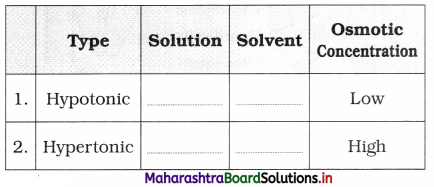
Answer:
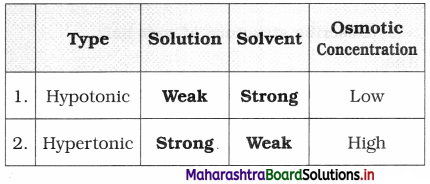
Question 2.
Complete the table.
| Event | Physical process |
| 1. Soaking of Seeds | —————- |
| 2. Water entering guard cells | —————- |
| 3. Exchange of gases | ————— |
| 4. Loss of water in liquid form | ————— |
| 5. Water coming out through earthen pot | ————— |
| 6. Loss of water in vapour form | ————— |
| 7. Absorption of solutes passively by carrier | ————— |
| 8. Spreading of fragrance of incense stick | ————— |
Answer:
| Event | Physical process |
| 1. Soaking of Seeds | Imbibition |
| 2. Water entering guard cells | Osmosis |
| 3. Exchange of gases | Diffusion |
| 4. Loss of water in liquid form | Guttation |
| 5. Water coming out through earthen pot | Diffusion |
| 6. Loss of water in vapour form | Transpiration |
| 7. Absorption of solutes passively by carrier | Facilitated Diffusion |
| 8. Spreading of fragrance of incense stick | Diffusion |
Diagram based questions
Question 1.
Zones of root
Answer:
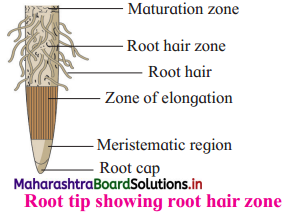
Question 2.
Structure of root hair
Answer:
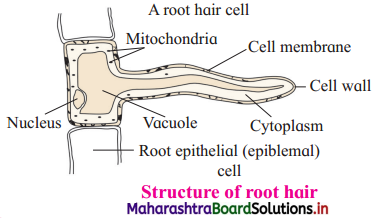
Question 3.
Diffusion of water
Answer:
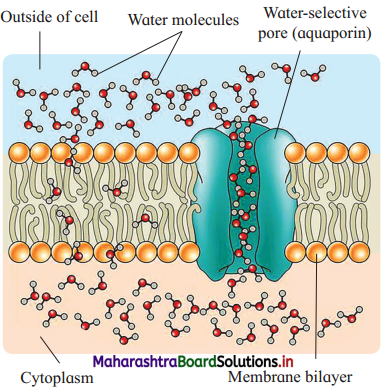
Question 4.
Pathway for water uptake
Answer:
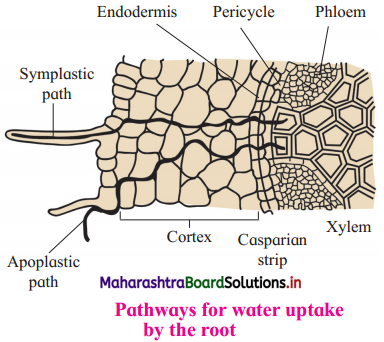
Question 5.
L. S. of sieve tube (Transport of food)
Answer:
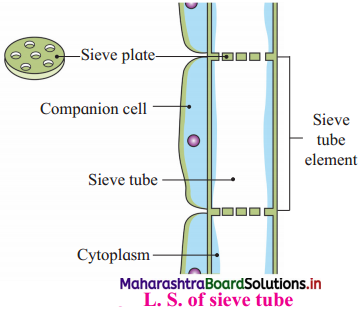
![]()
Question 6.
Structure of stomata and Types of guard cells
Answer:
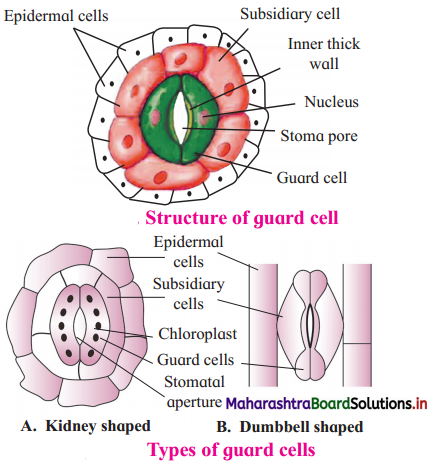
Long answer questions
Question 1.
Write a note on macronutrients and micronutrients required for plant growth.
Answer:
- Plants absorb mincral nutrients from their surroundings.
- For a proper growth of plants about 35 to 40 different elements are required.
- Plants absorb these nutrients in ionic or dissolved form from soil with their root system e.g. Phosphorus as PO4–. Sulphur as SO42- etc.
- Based on their requirement in quantity. they are classified as major nutrients or macronutrients and those needed In small amounts are minor or micronutrients.
- Macroclements are required in large amounts, as they play nutritive and structural roles e.g. C, H, O. R Mg. N, K. S and Ca. -Ca pectate cell wall component. Mg component of chlorophyll.
- C. H, O are non-mineral major elements obtained from air and water e.g. CO2 is source of carbon, Hydrogen from water.
- Microelements arc required In traces as they mainly have catalytic role as co-factors or activators of enzymes.
- Microelernents may be needed for certain activity in life cycle of plant e.g. B for pollen germination, Si has protective role during stress conditions and fungal attacks, Al enhances availability of phosphorus.
- The Important micronutrients for plant growth are Mn. B. Cu, Zn, Cl.